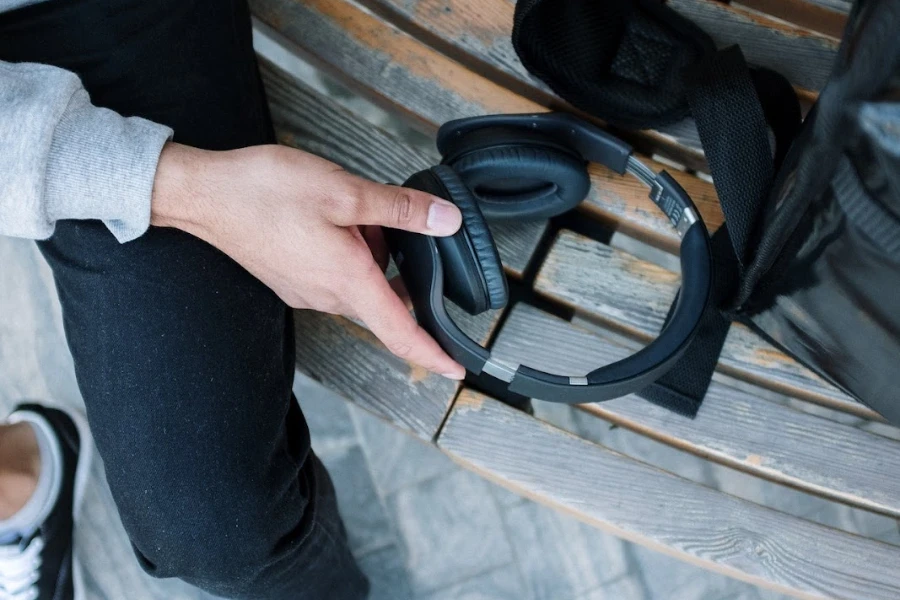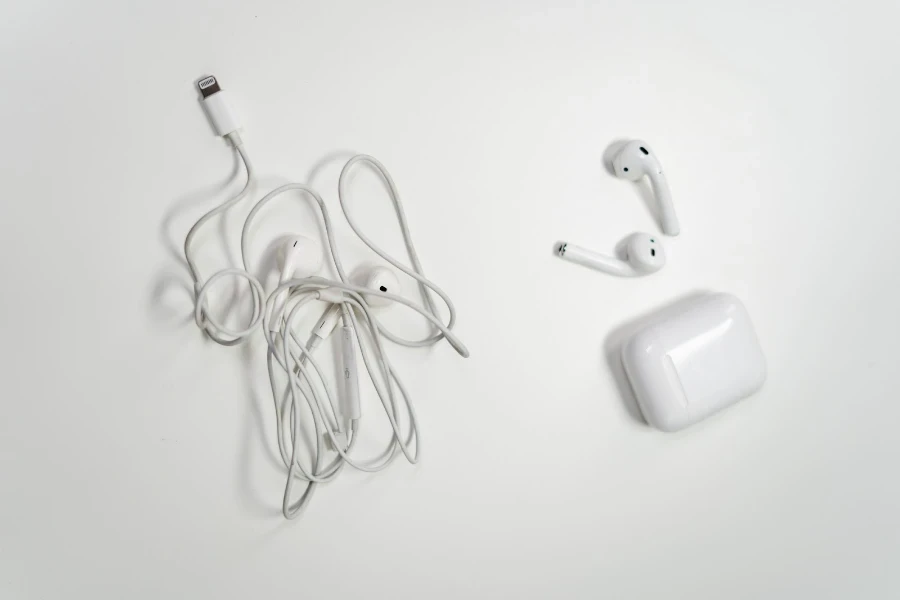Headphones have become extremely popular and are seen by many as an essential accessory not just for sound but also for fashion. Due to their popularity, the headphone market is booming. With a wide variety of headphone options, choosing the best pair can be extremely challenging.
Here we will delve into a comprehensive comparison of different types of headphones: over-ear vs. on-ear and earbuds vs. in-ear. We will explore the advantages, disadvantages, and popular models within each category, equipping you with the knowledge needed to decide when selecting which headphones to carry.
But why is it so important to choose the right type of headphones? The answer lies in the impact it has on the audio experience. The type of headphones you choose can significantly affect sound quality, comfort, portability, and overall performance. Opting for the wrong type may result in subpar audio quality, discomfort during extended use, or limitations in functionality.
So, join us as we dive into the world of headphones and compare the pros and cons of over-ear vs. on-ear and earbuds vs. in-ear headphones. Discover the unique features and popular models, and find the perfect headphones that match your consumers’ audio preferences.
Table of Contents
Overview of the headphone market
Over-ear vs. on-ear: What’s the difference?
Earbuds vs. in-ear: What’s the difference?
Factors to consider when choosing headphones
Which headphones are best for you?
Overview of the headphone market
In 2022, the global headphone market size was USD 58.3 billion, and it’s expected to reach USD 126 billion by 2030 with a compound annual growth rate (CAGR) of 12.6%. Advancements in technology around wireless connectivity and active noise cancellation have been significant factors in the growth in the headphone market.
In 2023, earbuds have had the highest overall search volume from customers. Comparing over ear versus on ear headphones, the search volume for over ear headphones has been double that of on ear headphones in 2023.
Wireless headphones have continued to grow in popularity, and in 2021 they accounted for 76.2% of the market. This is due, in part, to fitness enthusiasts driving the market. Those using headphones for fitness don’t want their listening experience to be a hassle of untangling cords or being connected to their devices via wire. The use of headphones for fitness has also increased the demand for durability in materials and waterproof sweatproof devices that can be used in the rain.
When looking at headphone prices, the USD 50 to 100 segment dominates with 39% of the market.
Over-ear vs. on-ear: What’s the difference?
Two popular options often come to mind when choosing headphones: over-ear and on-ear headphones. While they may seem similar at first glance, these two headphones have distinct differences that can greatly impact the users’ audio experience.
Over-ear headphones
As the name suggests, over-ear headphones envelop your entire ear within the ear cups. They are designed to fully enclose the ears, creating a seal that isolates external noise and immerses you in your audio. These headphones are typically larger and bulkier than on-ear models but offer several advantages.
Advantages of over-ear headphones
- Superior sound quality: Over-ear headphones are known for their exceptional sound quality. The large drivers and closed-back design allow more accurate sound reproduction, offering a wide frequency response and detailed audio experience. Some consumers will opt for wired over-ear headphones to further increase the sound quality over wireless.
- Excellent noise isolation: The over-ear design provides exceptional noise isolation by blocking out ambient sounds. This feature is particularly beneficial in noisy environments or when you want to fully immerse yourself in your music or game.
- Comfort for extended wear: The cushioned ear cups of over-ear headphones distribute the weight evenly around your ears, providing long-lasting comfort, even during extended listening sessions.
Disadvantages of over-ear headphones
- Bulkiness and portability: One of the main disadvantages of over-ear headphones is their larger size and bulkiness. The ear cups and headband tend to be larger, making them less portable compared to on-ear or earbud headphones. This can be a drawback if you frequently travel or prefer headphones that are easy to carry around.
- Heat and sweat buildup: The enclosed design of over-ear headphones can lead to heat and sweat buildup around the ears, especially during prolonged use or in warmer environments. This can cause discomfort and affect the overall listening experience.
- Limited breathability: Some over-ear headphone models may lack proper ventilation, leading to reduced breathability. This can result in a “closed-off” feeling and may cause your ears to feel warm or stuffy over time.

On-ear headphones
On-ear headphones, on the other hand, rest directly on the ears without fully enveloping them. They have smaller ear cups compared to over-ear headphones, resulting in a different listening experience.
Advantages of on-ear headphones
- Portability: On-ear headphones are generally more compact and lightweight than their over-ear counterparts, making them easier to carry and suitable for travel or commuting.
- Good sound quality: Although they may not offer the same level of sound isolation as over-ear headphones, on-ear models still deliver respectable sound quality with decent bass response and clarity.
- Suitable for commuting: The on-ear design allows for better situational awareness as it doesn’t completely isolate external sounds. This feature can be beneficial for those who need to remain aware of their surroundings while listening to music on the go.
Disadvantages of on-ear headphones
- Limited noise isolation: While on-ear headphones provide some noise isolation, they are less effective than over-ear headphones in blocking out external sounds. The smaller ear cups and the fact that they rest on the ears rather than fully enclosing them can allow more ambient noise to seep in, potentially affecting your listening experience.
- Potential discomfort: Some users may find on-ear headphones less comfortable than over-ear headphones, especially during extended use. The pressure exerted on the ears can cause discomfort or even pain for some, particularly if the headphones have a tight fit or lack proper padding.
- Sound leakage: Due to the nature of their design, on-ear headphones are more prone to sound leakage. Sound can escape through the ear cups and be audible to people nearby, which can be inconvenient in quiet environments or public settings where you may not want to disturb others.
Choosing between over-Ear and on-ear headphones
The choice between over-ear and on-ear headphones ultimately comes down to personal preferences and specific needs.
- For those who prioritize immersive sound, excellent noise isolation, and extended comfort, over-ear headphones may be the ideal choice. For example, for gamers.
- On-ear headphones might be more suitable for those who value portability, situational awareness, and a balanced listening experience.

Earbuds vs. in-ear: What’s the difference?
When it comes to compact and portable audio solutions, earbuds and in-ear headphones are popular choices. While they may appear similar, key distinctions between these two types of headphones can significantly impact the listening experience.
Earbuds
Earbuds are small, lightweight headphones that rest on the outer part of the ear canal without entering it. They typically feature a rounded shape that fits snugly in the concha of the ear. Earbuds are commonly included with smartphones or music players.
Advantages of earbuds
- Portability: Earbuds are extremely portable due to their small size and lightweight design. They can be easily carried in pockets or bags, or even worn around the neck when not in use, making them convenient for on-the-go use.
- Ease of use: Earbuds are simple and require minimal adjustment or insertion into the ear. They can be quickly placed in the ears, allowing for immediate music playback or hands-free communication.
- Comfortable for extended wear: The non-intrusive design makes them comfortable for extended listening sessions. They do not exert pressure on the ear canal and are less likely to cause discomfort during long periods of use.
Disadvantages of earbuds
- Sound quality limitations: Due to their small size and design, earbuds generally offer a more limited sound quality compared to larger headphones. They may lack depth in bass response and overall clarity, leading to a less immersive audio experience.
- Limited noise isolation: While earbuds provide some noise isolation by resting in the outer ear, they do not create a seal in the ear canal. This means they are less effective at blocking external noise than in-ear headphones. Ambient sounds can still seep in and interfere with your listening experience.
- Stability and fit: Earbuds can be less secure and prone to falling out, especially during physical activities or movements. They may require frequent readjustment or have difficulties maintaining a consistent fit for some individuals, leading to potential interruptions in audio playback.
In-ear headphones
In-ear headphones, also known as in-ear monitors (IEMs), are inserted into the ear canal for a more secure and immersive fit. They often come with different sizes of silicone or foam ear tips to ensure a proper seal.
Advantages of in-ear headphones
- Noise isolation: In-ear headphones provide excellent noise isolation by creating a physical barrier between the ear canal and the external environment. The snug fit and the seal the ear tips create effectively block out ambient noise, allowing you to focus on your audio without external distractions.
- Enhanced sound quality: The seal created by in-ear headphones improves sound quality by preventing sound leakage and reducing interference from outside noise. This leads to improved bass response, clarity, and overall audio performance.
- Versatility and customization: In-ear headphones often come with interchangeable ear tips of different sizes and materials, allowing you to find the perfect fit for your ears. Some models offer additional features like detachable cables or customizable sound profiles, providing a tailored audio experience.
Disadvantages of in-ear headphones
- Insertion and discomfort: The insertion of in-ear headphones may cause discomfort or irritation for some users, particularly if the fit is not ideal or the materials used are not suitable for their ears. Finding the right ear tip size and material is crucial to ensuring comfort during extended use.
- Cleaning and maintenance: In-ear headphones require regular cleaning and maintenance to keep them hygienic and in optimal condition. Ear wax or debris can accumulate on the ear tips and affect the sound quality and the overall performance of the headphones.
- Reduced awareness of surroundings: While beneficial for audio immersion, the excellent noise isolation provided by in-ear headphones can also be a disadvantage in certain situations. Complete isolation from external sounds may limit your awareness of your surroundings, which can be a safety concern, especially when used in outdoor or urban environments.
Choosing between earbuds and in-ear headphones
Choosing between earbuds and in-ear headphones depends on personal preferences and specific needs.
- For those whose ease of use is the primary concern, earbuds may be a suitable choice.
- For those prioritizing noise isolation, enhanced sound quality, and a more personalized fit, in-ear headphones might be the better option.
Factors to consider when choosing headphones
When choosing headphones, there are several factors to consider to ensure you select the right pair that suits your needs and preferences.
- Sound quality: Sound quality is a crucial aspect of headphones. Look for headphones that offer a balanced and accurate audio reproduction, with clear highs, detailed midrange, and well-defined bass.
- Comfort and fit: Comfort is vital, especially if you plan on using the headphones for extended periods. Consider the weight, earpad materials, and headband design to ensure a comfortable fit. Adjustable headbands, cushioned ear cups, and ergonomic designs can enhance comfort and prevent fatigue.
- Portability and intended use: Think about how and where you will use the headphones. If you travel frequently or need them for on-the-go use, consider compact and foldable designs that are easy to carry. For active use, look for headphones with a secure fit and durability. Comfort and sound quality may be more important than portability if they’re used primarily at home.
- Wired or wireless: Decide whether you prefer wired or wireless headphones. Wired headphones provide consistent audio quality but may restrict movement. In contrast, wireless headphones offer freedom of movement but may have potential latency or audio quality limitations. Also, consider battery life and connectivity options for wireless headphones.
- Noise isolation or cancelation: Consider whether you want headphones with noise isolation, or active noise cancellation (ANC) features depending on your needs. Noise isolation passively blocks external sounds, while ANC uses microphones and technology to reduce ambient noise. These features are beneficial in noisy environments or for immersive listening experiences.
- Durability and build quality: Consider the durability and build quality of the headphones, especially if you plan to use them regularly or in demanding situations. Look for sturdy materials, reinforced cables, and reliable construction to ensure longevity.
- Price range and budget: Set a budget that aligns with your requirements and expectations. Determine how much you’re willing to spend on headphones and explore options within that price range. Keep in mind that higher-priced headphones often offer better sound quality and additional features, but there are also affordable options that provide good value for money.

Which headphones are best for you?
Each type of headphone offers unique advantages and considerations that can impact customer satisfaction and drive sales.
With their superior sound quality and immersive experience, over-ear headphones are perfect for audiophiles and those seeking the highest level of audio fidelity. On-ear headphones, however, balance portability and sound quality, making them suitable for commuters and those looking for convenience.
Earbuds offer unparalleled portability and ease of use, making them a popular choice; their compact size and versatility appeal to individuals leading active lifestyles or frequently on the move. In-ear headphones excel in noise isolation, ensuring a distraction-free listening experience, and can be customized to fit each customer’s unique ear shape.
By stocking a variety of headphones that meet consumer needs, you can position your tech business as a trusted source for audio solutions and provide customers with options that suit their individual preferences. This customer-centric approach will enhance customer satisfaction, drive sales, and foster long-term loyalty to your brand.




